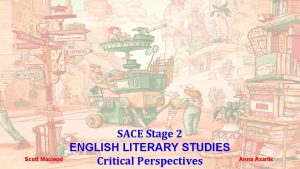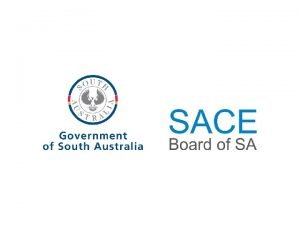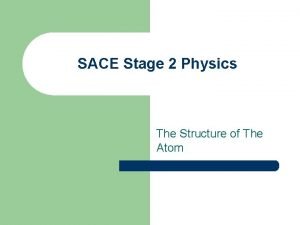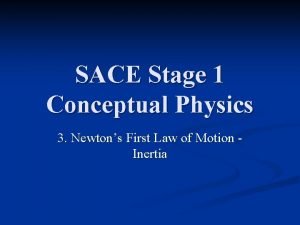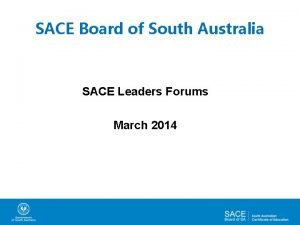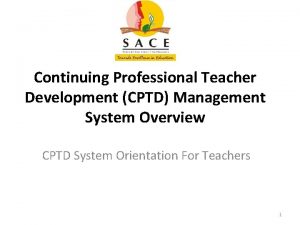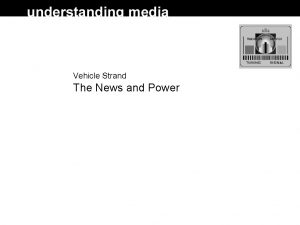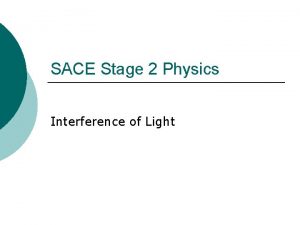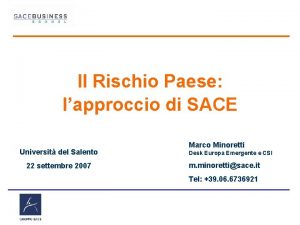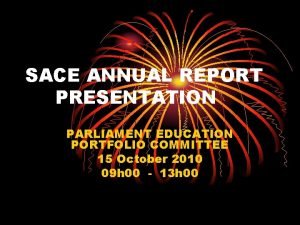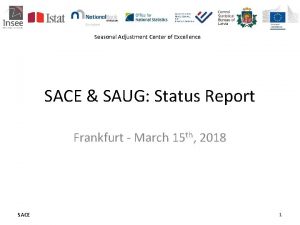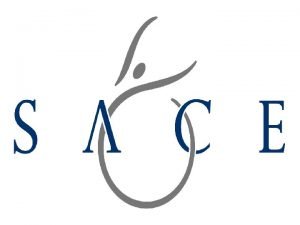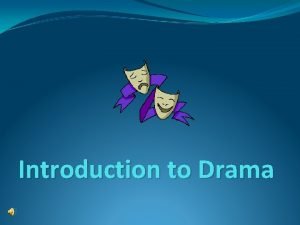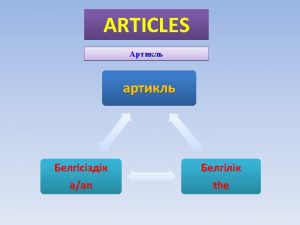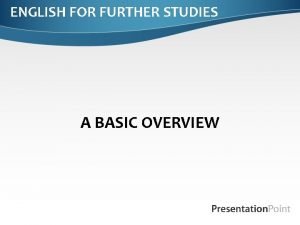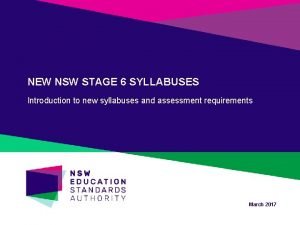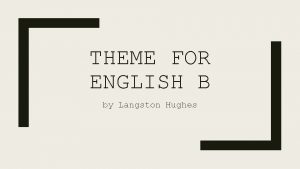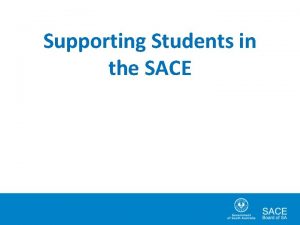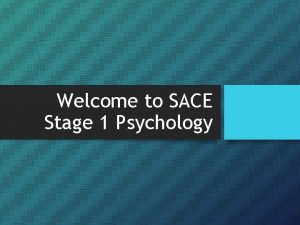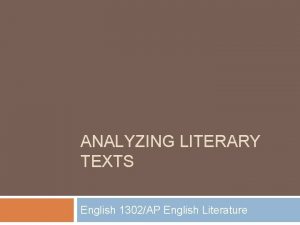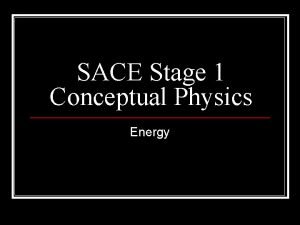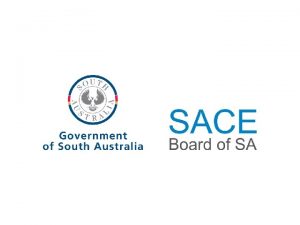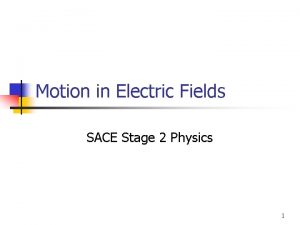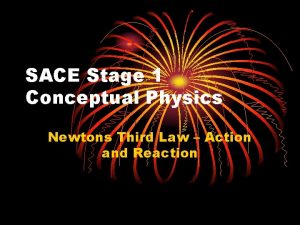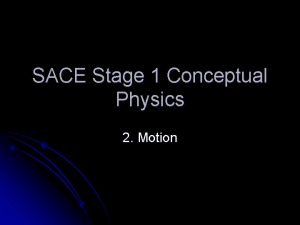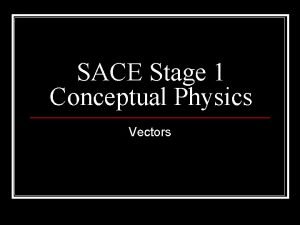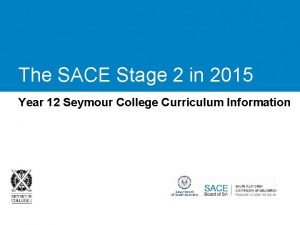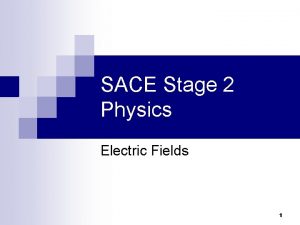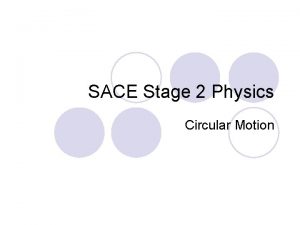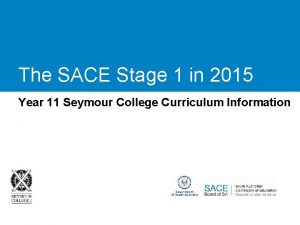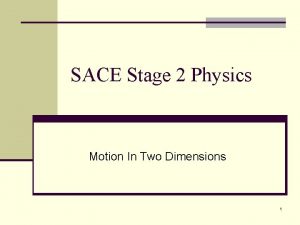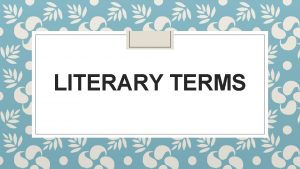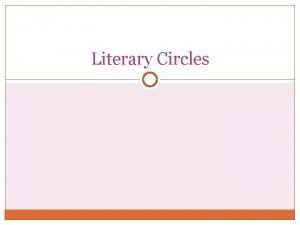Scott Macleod SACE Stage 2 ENGLISH LITERARY STUDIES


























- Slides: 26

Scott Macleod SACE Stage 2 ENGLISH LITERARY STUDIES Critical Perspectives Anna Axarlis

PRESENTATION OVERVIEW • The purpose of critical perspectives in the study of English • SACE outline of the assessment task for English Literary Studies • Student/Teacher Expectations • A Marxist Approach to ‘Itsy Bitsy Spider’ • How to integrate and utilise dominant critical perspectives • Examples of SACE approved texts and relevant critical perspectives • Assessment task design for One Flew Over The Cuckoo’s Nest

CRITICAL PERSPECTIVES Academic, Deborah Appleman, asserts that ‘literary theories were developed as a means to understand the various ways people read texts. The proponents of each theory believe their theory is theory, but most of us interpret texts according to the “rules” of several different theories at a time. ’ This is apparent when we consider that all literary theories are essentially lenses through which we can see texts. As Appleman states, ‘there is nothing to say that one is better than another or that you should read according to any of them, but it is sometimes fun to “decide” to read a text with one in mind because you often end up with a whole new perspective on your reading. ’ Deborah Appleman, ‘Critical Theories Defined’

SACE ASSESSMENT OUTLINE The SACE Glossary contextualises ‘perspective’ as ‘the way a reader/viewer is positioned by the author through the text, or how a particular ideology is embedded in a text’ (e. g. a feminist perspective). In completing this task, students have the opportunity to: • Develop an understanding of how a how text may be interpreted from a range of critical perspectives and that each may emphasise different textual features. • Deepen their knowledge of the text by developing and supporting their own interpretations. • Emphasise the role of the author or the role of the reader in shaping the ‘meaning’ of the text through consideration of contrasting critical perspectives. • Focus on the text as a socio-cultural product or as an artefact that stands apart from its historical context.

SACE OUTLINE ‘Some critical interpretations present a blend of such emphases, while others adopt one as the primary lens through which a text may be read. Through their study, students will develop an understanding of the assumptions that shape critical analysis. Such assumptions may, for example, be about the virtues of particular forms and styles, cultural and personal values and beliefs, or perceptions about the status of the author. ’ SACE ‘Stage 2 English Literary Studies: 2017 Subject Outline’

STUDENT EXPECTATIONS?

TEACHER EXPECTATIONS?

A MARXIST APPROACH. . .

CRITICAL PERSPECTIVES Below is just a sampling of the critical perspectives that can be applied to any of the texts from the SACE English Literary Studies Prescribed List. Archetypal Biographical Eco-criticism Feminist Historical Marxist Political structuralism Deconstruction Gender Moral Post-colonial Post-

ARCHETYPAL ‘Archetypes’ can represent narrative structures, themes, characters, or images that re -appear across the literary and textual traditions. This perspective typically involves the analysis of these recurrent literary attributes within diverse cultural contexts. • Archetypal criticism chiefly owes its origin to the pioneering work of pre-eminent psychologist Carl Jung, who argued that humanity has a collective unconscious that manifests itself in dreams, myths, and literature. • Some theorists argue that the presence of certain recurrent images, plots, and character types is ‘ipso facto evidence of their status as memories in the collective unconscious. ’ • Meanwhile, other critics use the term ‘archetype’ in a more restrictive sense to identify and contextualise recurrent elements and patterns in literature without direct reference to Jung’s theory of the collective unconscious. The Bedford Glossary of Literary Terms (2009)

QUESTIONS AND PROMPTS • How are archetypal characters (i. e. a hero, ruler, innocent, orphan, magician, explorer, rebel) conveyed in the text? • Does the protagonist embark on a journey of transformation in either a physical or spiritual sense? What trials or tribulations do they encounter? • What connections can be made between elements of the text and the dominant archetypes? • How does the text utilise archetypal plots or narrative patterns? (i. e. Rags to Riches, the Quest, Rebirth). • How are archetypal situations and events (i. e. battle of good versus evil, coming-ofage transition from adolescence into adulthood) depicted in the text? • How are archetypal symbols, images, and themes (i. e. the snake, a sword, the garden, colours, or numbers) presented in the text? Adapted from ‘The Writing Lab’ (Purdue University)

CRITICAL ASSUMPTIONS Central Concerns: myth, image, dreams, rituals, pattern, model. • Imaginative work is indebted to ancient systems of meaning, including ritual, mythology, and inherited symbolism (the ‘collective unconscious’). • There are no ‘new’ stories. • Conflicts, characters, and symbols in fiction and poetry come from the same place as dreams and can be interpreted the same way dreams are. Deborah Appleman, ‘Critical Encounters in Secondary English: Teaching Literary Theory to Adolescents’ (2015)

GENDER A form of literary criticism that seeks to challenge the roles, representations, and social constructs of what it means to be male and female, as well as consider the relationships between such genders. This often includes: • A distinction between the identities and characteristics associated with the concept of gender (masculinity/femininity and the biological identification). • A rejection of the essentialist view that gender is natural or innate, instead taking the constructionist perspective that gender is a social artifact, a learned behaviour, and a product of language and culture. • As a critical perspective, gender discourse arose out of feminist criticism, with commentators drawing on feminist theory and practice to inform their analysis. • The critique of gender as a category of analysis continues to evolve and expand, as cotemporary readings challenge the reliance on gender identification at all. (2009) The Bedford Glossary of Literary Terms

QUESTIONS AND PROMPTS • Does the gender of the author influence the character perspectives and voices represented in the text? • What elements of the text can be perceived as being masculine and feminine, and how do the major characters support or subvert these roles? • What sort of support (if any) is given to key elements or characters who question the masculine/feminine codes? What happens to those elements/characters? • How does the text reinforce, critique, or challenge gender stereotypes within the social and historical framework of the text? • How do readers of different genders interpret the text? Adapted from ‘The Writing Lab’ (Purdue University)

CRITICAL ASSUMPTIONS Central Concerns: gender roles, objectivity/objectification, representation, difference. • Historically, writing (and interpretation) has been dominated by men and masculine perceptions – it is important for women to create a feminist way of writing and reading. • Men and women are essentially different, and differences can be examined in social behaviour, ideas, and values – these differences should be recognised. • Stereotyping is dangerous and can lead to destructive social norms. Deborah Appleman, ‘Critical Encounters in Secondary English: Teaching Literary Theory to Adolescents’ (2015)

HISTORICAL A critical perspective that examines the relationship between a literary text and its historical milieu, specifically in relation to the cultural and social factors that have influenced and are revealed throughout the text. • This form of criticism emerged in the nineteenth century as a reaction to the Enlightenment era and emphasis on reason. Historicists have ‘privileged history as the basis for understanding and evaluation and have sought to link the present and the past. ’ • In this context, history refers to the social, political, economic, cultural, and/or intellectual climate of the time and place in which the text has been created. • As a result, many critics use this lens to focus on the interplay between the text and historical contexts, including the author’s life or intentions in writing the work. The Bedford Glossary of Literary Terms (2009)

QUESTIONS AND PROMPTS • How does the time and place in which the author wrote dictate the creation and purpose of the text? • How does the culture of the author influence his or her perspective on society, specifically in relation to the interpretation and presentation of major events? • Does the text function as part of a continuum with other historically significant literary texts written in the same period? • How do the major characters in the text represent the attitudes and values of the respective time and place in which it is set? Consider the depictions of social class, prejudice, inequality, racism, and stereotypes. • How does the text portray dominant historical, cultural, and political figures or movements of the respective era? • How would the reader at the time the text was written, or the cultural context in which it was written, respond to the text? Adapted from ‘The Writing Lab’ (Purdue University)

CRITICAL ASSUMPTIONS Central Concerns: history as a cultural construction, how literature is shaped through a historical context. • Meaning is contextual. • There are divergent viewpoints on the nature of historical context. • Interpretation is a form of cultural production, which is marked by a particular context. We must consider the importance of events in relation to literature as a product of culture and our time. Deborah Appleman, ‘Critical Encounters in Secondary English: Teaching Literary Theory to Adolescents’ (2015)

CHOOSING PERSPECTIVES Some things to be mindful about when considering critical perspectives for this assessment task: • The perspectives are not always mutually exclusive, but you should be aware which are incompatible by understanding the assumptions behind them. • No single perspective offers the clearest view of a text – remember that all have limitations in some form. • Applying different perspectives to the same text can reveal new features of that text. • Depending on your class cohort, it may be easier to apply one perspective at a time. • Utilising these perspectives to reflect upon your own experiences can help in regards to understanding and thinking critically about your own ideologies. • Writing about literature affords us the ability to discuss real issues in the realms of the imagination. In other words, we can have a bit of fun and play around! Deborah Appleman, ‘Critical Encounters in Secondary English: Teaching Literary Theory to Adolescents’

TEXTS AND EXAMPLES Below are some prominent examples of texts from the SACE English Literary Studies Prescribed List with the dominant perspective and several possible critical perspectives to use for the assessment task: Text Dominant CR Potential CR #1 Potential CR #2 Gender Archetypal Psychological Perfume (novel) Psychological Moral Sociological Psycho (film) Psychological Gender Archetypal Sociological Gender Cultural The Glass Menagerie (play) Gender Moral Sociological A Doll’s House (play) Gender Historical Cultural Sylvia Plath (poetry) Psychological Gender Historical Postcolonial Historical Gender The Handmaid’s Tale (novel) Jindabyne (film) Judith Wright (poetry)

ASSESSMENT TASK DESIGN • Compose an analytical response (1, 500 words / 9 minutes in length) that examines how Ken Kesey’s One Flew Over the Cuckoo’s Nest can be interpreted from both a gender and historical perspective. • This assessment task will require you to utilise critical thinking and communication skills in order to address how these perspectives illuminate different elements of the text. • By presenting an informed and sustained interpretation through the application of critical perspectives, you will have the opportunity to evaluate your own and others’ justifications, evidence, and points-of-view. Choose one of the following options: 1. Create a fictional interview/dialogue featuring two literary scholars that comparatively examines One Flew Over the Cuckoo’s Nest from both a gender and historical perspective. This can be presented as either a written transcript (1, 500 words) or a multimodal presentation (9 minutes). 2. Construct a series of paragraph responses (1, 500 words in total) that comparatively examines One Flew Over the Cuckoo’s Nest from both a gender and historical perspective. You can use the prompts and questions provided to shape your analytical response.

ASSESSMENT CRITERIA Knowledge and Understanding of … KU 1 KU 2 Ways in which ideas, perspectives, and values are represented in texts. Ways in which authors use stylistic features to communicate ideas. Analysis An 1 Of ways in which texts represent ideas, perspectives, and values. An 2 And evaluation of ways in which stylistic features are used to influence the interpretation of texts. An 4 Of ways in which different critical perspectives inform interpretation. Application Ap 1 Use of conventions and stylistic features to create coherent texts that address the meaning and intention of the task. Ap 2 Use of evidence from texts to develop, support, and justify responses. Ap 3 Use of accurate, clear, and fluent expression appropriate for purpose and audience.

READING JOURNAL In order to fully appreciate and understand the complexity of the selected text, students naturally must reflect on the major characters, events, ideas, and themes as they are reading. Keeping a reading journal as a formative task can help document the experience of reading and allow for learning through self-reflection, particularly in relation to the ideas and emotions that the text can conjure. Students could compose a series of entries including, but not limited to: • Written responses to specific ideas, events, or scenes in the text. Write about what comes to mind when you are reading. Do you find yourself relating to a specific character or experience? What are your thoughts on the main themes in the text? Are the language techniques and stylistic features engaging and effective at conveying the plot and subject matter? • Diagrams, images, and illustrations that are relevant to the text. This could be a timeline of the events as they occur (different plot lines), mind map of the central characters, or even a Venn diagram exploring the connection between themes and critical perspectives. Sketches of characters and scenes, or even images that you feel are connected to or inspired from the text would also be applicable. • Key quotations or questions from the text that you think are significant. Identifying words, references, or character actions that are particularly interesting or you don’t fully understand. There may also be descriptions or quotations that you find significant and want to research later.

READER-RESPONSE Below is a table that could also be useful when encouraging students to interpret the selected text through several critical perspectives. Research and information gathered would inform the subsequent summative assessment Criteria relevant totask. literary criticism of text Perspective #1 Perspective #2 Personal Response Author’s life and times Central ideas and themes Recurring images, symbols, motifs Allusions and intertextual connections Key characters Setting and social context Narrative and plotting of events Language and literary techniques Adapted from the Victorian Certificate of Education: Literature – Advice for Teachers (2016)

PERFORMANCE STANDARDS Knowledge and Understanding Analysis Knowledge and understanding of ways in which ideas, perspectives, and values are represented in texts. Analysis of ways in which texts represent ideas, perspectives, and values. Knowledge and understanding of ways in which authors use stylistic features to communicate ideas. Knowledge and understanding of the stylistic features and conventions of different text types. Application Use of conventions, and stylistic features to create coherent texts that address the meaning and intention of Analysis and evaluation of the task. ways in which stylistic features are used to Use of evidence from texts influence the to develop, support and interpretation of texts. justify responses. Analysis of similarities Use of accurate, clear, and differences between fluent expression texts in comparative tasks. appropriate for purpose and audience. Analysis of ways in which different critical perspectives inform interpretation.

ANY QUESTIONS? Email: scott. macleod@adelaidehs. sa. edu. au anna. axarlis@adelaidehs. sa. edu. au
 Sace english literary studies
Sace english literary studies Sace stage 2
Sace stage 2 Sace wawe
Sace wawe Sace stage 2 physics
Sace stage 2 physics Sace physics
Sace physics Sace aggregate
Sace aggregate Cptd points
Cptd points Plato sace
Plato sace Reinforcement and annulment of waves
Reinforcement and annulment of waves Scheda paese sace
Scheda paese sace Sace annual report
Sace annual report Sace center
Sace center Sace export plus
Sace export plus Paradigm shift from women studies to gender studies
Paradigm shift from women studies to gender studies Phase one denial
Phase one denial The position of the acting area in relation to the audience
The position of the acting area in relation to the audience Directions types
Directions types What is a two stage tender
What is a two stage tender What is drama
What is drama House left vs stage left
House left vs stage left He studies english
He studies english English for further studies
English for further studies What is a literary device in a poem
What is a literary device in a poem Life skills outcomes stage 6
Life skills outcomes stage 6 Essential english stage 1
Essential english stage 1 Romeo and juliet translation act 1
Romeo and juliet translation act 1 Theme for english b literary devices
Theme for english b literary devices
